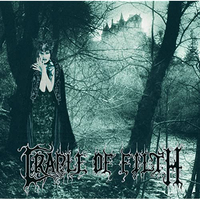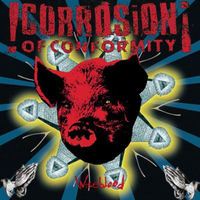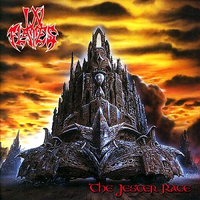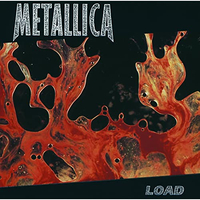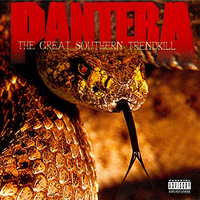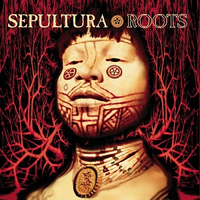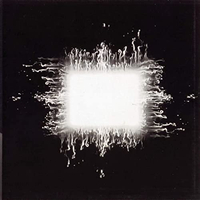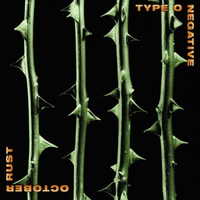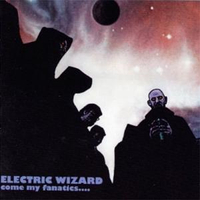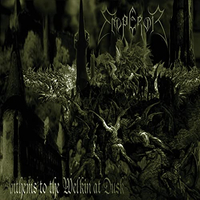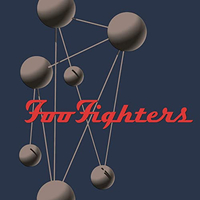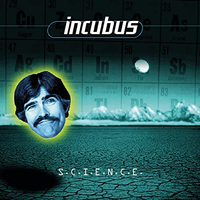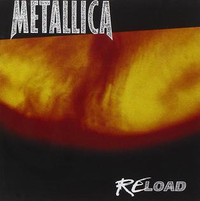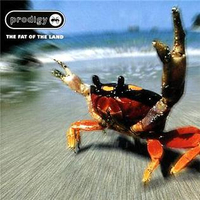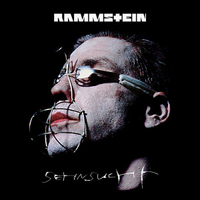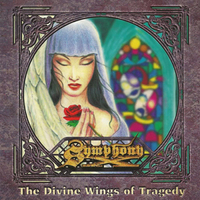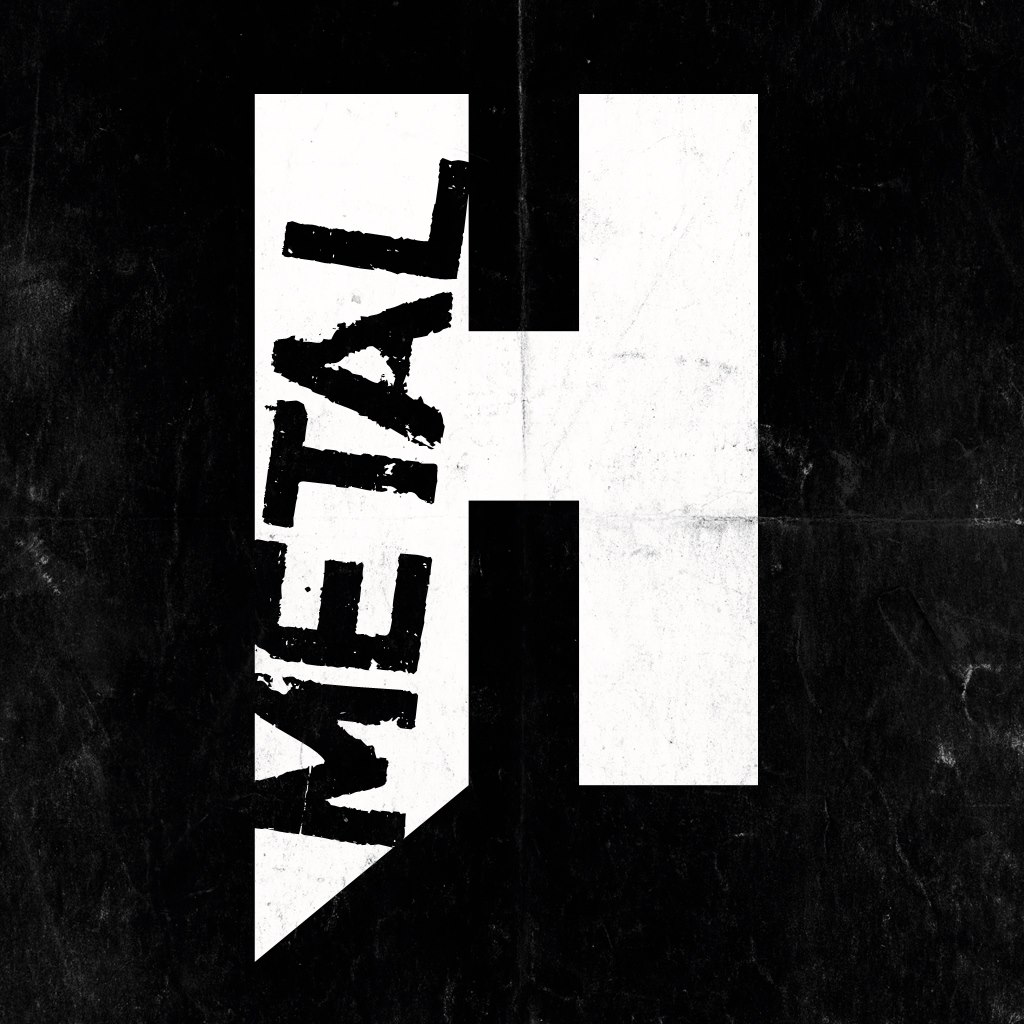Cradle Of Filth - Dusk… And Her Embrace
The pinnacle of Cradle Of Filth’s ‘green period’ – as Dani has called it – Dusk… is a masterclass in extreme metal and, to most, the defining Filth record. Epics such as Heaven Torn Asunder and A Gothic Romance (Red Roses For The Devil’s Whore) are inspired by Sisters Of Mercy as much as they are Emperor, taking the ugly face of black metal and spurting a garishly gothic seed all over it.
Creepy keyboards and warbling female vocals are one of the record’s focal points, but the sheer strength of the riffs which encase them is unquestionable. The title track and Funeral In Carpathia both boast melodious leads and harmonies that would make Iron Maiden weep; the latter also packs Sarah Jezebel Deva’s immortal cry of ‘Never leave me!’ and stakes its claim for the best Cradle song ever.
Put simply, Dusk… And Her Embrace is a masterpiece. Everything from Dani’s yearning, Byronic lyrics to the expansive production values; from Nicholas Barker’s infernal drumming to Venom’s Cronos popping up on album closer Haunted Shores just reeks of ambition, and most bands in this situation would crumble like biscuits under the feet of Stormtroopers. Not Cradle Of Filth.
Corrosion Of Conformity - Wiseblood
The story of Corrosion Of Conformity is almost certainly unique in metal, primarily because they have changed heavy music irrevocably on at least two separate occasions. This album marked the culmination of their journey from hardcore snarlers to Southern-rock-infused metallers.
With Pepper Keenan installed as frontman, 1994’s Deliverance and its 1996 follow-up Wiseblood established COC as leading lights in the then-flourishing stoner rock and doom scenes, re-injecting some much-needed Iommi-saluting heft into mainstream metal.
Nice Papa Het cameo, too.
In Flames - The Jester Race
The Swedes recruited Anders Fridén for their classic second album, proving the Gothenburg Sound was no mere flash in the pan.
They would make bolder and better records further down the line, but In Flames’ second studio outing established a thrilling, effervescent blueprint for the Gothenburg scene’s most successful band.
It’s a simple formula – Maiden-style melody with a death metal delivery – but a gloriously effective one that has had a colossal, enduring impact on how metal sounds today.
Metallica - Load
Newly shorn and sporting eyeliner, Metallica backed off further from thrash metal here.
Ever the stoic, James Hetfield left the guyliner to the poseurs and attended to more serious matters, reflecting upon his mother’s death in the southern rock ballad Mama Said, facing his demons on the portentous Bleeding Me, spitting pure vitriol on the Motörhead-inspired Ain’t My Bitch.
Load marked a new era: where The Black Album had included a little token thrash metal, Load had none. Metallica put their own past behind them. Their most controversial album – well, until Lulu surfaced – and their most underrated.
Neurosis - Through Silver In Blood
Having worked their way up through the crust punk scene in the late 80s, Neurosis began to evolve into a far more dangerous beast during the following decade.
The album Through Silver In Blood finally captured the nightmarish hell inside their collective head in all its savage glory. A percussive, hypnotic sonic assault dressed up as post-metal.
This was their pinnacle: metal reinvented as tribal ritual.
Pantera - The Great Southern Trendkill
After three such groundbreaking and essential albums as Cowboys…, Vulgar… and Far Beyond… Pantera were faced with something of a quandary. Should they stick to their guns and deliver another high-octane set of brutal, headcrushing metal, or try to do something slightly different?
Brothers Dimebag and Vinnie Paul were both keen on the latter, singer Anselmo favoured the former. Bassist Rex, never the most voluble member, probably kept his opinions to himself.
The resulting album proved the brothers had won out, and The Great Southern Trendkill is easily the most diverse of the modern-day Pantera albums, even dipping into balladry on the likes of 10’s and Suicide Note Pt. 1.
Lyrically, Anselmo’s normal poetic angst was replaced by drug-related diatribes and rants at the media, showing something, somewhere, was very wrong indeed.
Rage Against The Machine - Evil Empire
Rage’s second album fanned the flames lit by their debut. Money men, arms dealers, shock jocks – all were in their sights.
Evil Empire represented everything great about the band: the steadfast groove of its rhythm section driven by Brad Wilk’s urgent stop-start drum fills and the crunchy distortion of Tim Commerford’s bass, the unmistakable wah-wah guitar work of Tom Morello and his impenetrable solos that flip from explosive riffing to turntable scratching at the flip of a hat, and the rapid politicised polemic of vocalist Zack De La Rocha.
Aside from that, it’s a scathing lambaste of US society, seething in anger and explosive in deliverance, and a fine example of the rousing mix of music and politics that made Rage Against The Machine such an unstoppable force.
Sepultura - Roots
First Sepultura smashed the boundaries between punk and thrash. Then they invented a whole new genre – the Brazilian quartet’s breathtaking musical vision came to full fruition here.
The first song that anyone heard from the Roots sessions was, of course, the mighty Roots Bloody Roots. To this day, the defining moment of both Sepultura’s and Max’s careers, this pummelling tirade of rumbling riffs, thudding percussion and Max’s throat-rending call-to-arms vocal was an instant classic when it was released as a single shortly before the album’s release.
The defining moment of the Roots recording sessions came at the very end of the process, when Sepultura travelled to the depths of the Brazilian rainforest to record Itsári in collaboration with the indigenous Xavante tribe; the fulfilment of Max’s Roots concept.
A glorious epitaph for the legendary Max Cavalera era.
Tool - Aenima
The first Tool album to be recorded by the classic line up, with former Peach bassist Justin Chancellor joining the band for the first time, was to be the record that really established the band as genuine one-offs.
Aenima is the first time where Tool sounded like nobody else but Tool. Weird, esoteric, sarcastic, unsettling, progressive, complex, involving... it is a masterclass in teasing the listener and keeping them on their toes.
Stinkfist was the big single, but the nine-minute build of Eulogy (going from two notes to a wall of furious noise) or the psychedelic nightmare trip of the closing Third Eye (possibly their finest song) really showed the world the real Tool for the first time.
Ritual magick, sacred geometry and the comedy of Bill Hicks – like nothing before or since.
Type O Negative - October Rust
After a prank opener and a jovial message of thanks from the band, this autumnal epic represents the culmination of Type O Negative’s progress from ugly ducklings to ugly swans, honing their dreamy alt-pop sensibilities while nailing some of their most affecting doom atmospheres in Red Water, Wolf Moon and Haunted.
But it’s the lush harmonic textures and radiant romanticism that proved the biggest revelation, holding the attention for 70+ minutes of unorthodox beguilement.
Peter Steele fleshed out his band’s grandiose vision here – and wrote the perfect gothic pop song in My Girlfriend’s Girlfriend.
Deftones - Around The Fur
An album that turned Deftones into the hottest band on the planet (certainly in the UK), Around The Fur is more thoughtful and features greater depth than Adrenaline.
But they were still as heavy as any metal band around, as heard on the breakneck lotion or hearing Chino Moreno trading vocal lines with Max Cavalera on Headup.
Crucially though, Around The Fur features at least two of the times most anthemic songs in Be Quiet And Drive (Far Away) and the awesome My Own Summer (Shove It), which are still staples in their live set today.
Electric Wizard - Come My Fanatics…
The misanthropic Dorset doom-mongers journeyed into metal’s darkest places on their second record. The music was fully enveloped in an impenetrable acrid haze – more so than just about any other record that dare tag itself as ‘stoner’.
The likes of fuzz-drenched opener Return Trip and the disorientating Doom-Mantia are the sound of your sanity drifting out of the window. Drugs may have been involved – and they were bad ones.
RIYL: Pot-induced psychotic breakdowns and Russ Meyer movies.
Emperor - Anthems To The Welkin At Dusk
Emperor’s second album was the point at which black metal discovered its ambition.
Following the ground-breaking majesty of In The Nightside Eclipse, Emperor’s second full album smashed the opposition with its intensely elaborate and literate re-imagining of black metal’s atmospheric principles and sublime intricacy.
After this point, where Emperor led, everyone else followed.
Foo Fighters - The Colour And The Shape
Although the Foo Fighters’ debut had promised much, few people anticipated the powerful step up that Dave Grohl made with this follow- up. Even though he hired William Goldsmith to play drums, Grohl ousted him as soon as recording began. Gil Norton was brought in for his work with The Pixies, but the record was much tougher- sounding than them – slick, even.
Sounding like it was built with arenas in mind, it ushered in the post-grunge age with Grohl now a fully formed songwriter, and the heavily melodic groove of songs like Everlong and My Hero sat comfortably alongside the furious Monkey Wrench and the brooding Walking After You.
Incubus - S.C.I.E.N.C.E.
Surely one of the most diverse-sounding bands in nu metal, Incubus owe a great deal to the pioneering spirit of Faith No More, not least in the silky vocal stylings of Brandon Boyd and the left-field inventiveness with a high premium placed on strong melodies and instant hooks.
S.C.I.E.N.C.E. was the sound of a band clearly developing into a world-class act, and includes a number of tunes that still pop up in Incubus’s live shows over two decades on: Vitamin, Idiot Box and A Certain Shade Of Green.
For real feel-good innovation and a distinctly weird sense of humour, this record is pretty hard to beat.
Metallica - Reload
With Load front-loaded with the better songs, Reload picked up the slack from the writing sessions, and understandably suffers as a consequence.
While James Hetfield’s lyrics hit new peaks of maturity, too many of his riffs here are – to employ a Lars Ulrich passive-aggressive criticism – ‘stock’, and should have ended up in the Pro-Tools recycle bin. The Memory Remains is one hell of a tune though – ands let's be honest, a not great Metallica album is still a bloody good album by anyone else's standards, and was easily one of 1997's best records.
Load’s sister album had the same strengths and weaknesses as its predecessor, but when it was good, it was simply unstoppable.
The Prodigy - The Fat Of The Land
If Firestarter had laid the groundwork, then The Prodigy’s third album, The Fat Of The Land, sealed it for them. Released in June 1997, anticipation had reached fever pitch – the world was gagging for it.
Matters were helped along by another burst of controversy, this time surrounding the single Smack My Bitch Up and its no-holds-barred drug-taking’n’nudity video. After complaints about the track, the album was pulled from the shelves of certain record stores, but that didn’t stop it going to Number One in more than 20 countries including the US and UK.
The point at which rave culture collided with metal culture. Forget nu metal – this was the real sound of summer ’97, whether you approved or not.
Rammstein - Sehnsucht
The one with Du Hast on it. You know the one. Building on Herzeleid’s muscular sound, Sehnsucht delivers dollops of gothic noir alongside the usual punishment.
Spiel Mit Meir’s tales of incest are laced with Flake’s perversely playful keyboard, while Klavier’s dense, epic riffing showcases a mind-set that’d be properly addressed on Mutter.
Confrontational, provocative, utterly Teutonic: Sehnsucht proved there was way more to German metal than the Scorpions.
Symphony X - The Divine Wings Of Tragedy
The New Jersey band’s masterpiece was the point where power metal met prog.
It combined all the elements that make prog metal great – it was epic, slightly pretentious and overtly technical – and helped solidify the template for prog metal in the 90s and beyond.
An essential and important album that rarely gets the dues it's owed.
Strapping Young Lad - City
Taking the Fear Factory blueprint and extrapolating it, Strapping Young Lad read the rulebook, acknowledged it, wiped their arses with it and scissor-kicked it into the 41st millennium.
Gene Hoglan and Devin Townsend are the dream team here, melding steamy segments of double bass death and industrial metal to create instant-yet-terrifying anthems like Underneath The Waves and the spasmodic Oh My Fucking God.
This is the most intense, punishing and – thanks to Devin’s vocals – unique take on industrial you’ll ever hear, with the ‘skullet’-rocking Townsend in full on metal-god mode.
SYL’s debut was Heavy As A Really Heavy Thing, but this is where they cranked things up.
Metal Hammer Newsletter
Sign up below to get the latest from Metal Hammer, plus exclusive special offers, direct to your inbox!
